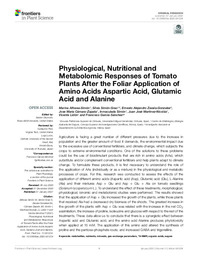Título :
Physiological, Nutritional and Metabolomic Responses of Tomato Plants After the Foliar Application of Amino Acids Aspartic Acid, Glutamic Acid and Alanine |
Autor :
Cámara-Zapata, José-María 
Alfosea Simón, Marina 
Zavala Gonzalez, Ernesto Alejandro 
Simón Vilella, Inmaculada 
Martinez Nicolas, Juan Jose 
Lidón Noguera, Vicente 
Garcia-Sanchez, Francisco  |
Editor :
Frontiers Media |
Departamento:
Departamentos de la UMH::Física Aplicada |
Fecha de publicación:
2021-01 |
URI :
https://hdl.handle.net/11000/33491 |
Resumen :
Agriculture is facing a great number of different pressures due to the increase in
population and the greater amount of food it demands, the environmental impact due
to the excessive use of conventional fertilizers, and climate change, which subjects the
crops to extreme environmental conditions. One of the solutions to these problems
could be the use of biostimulant products that are rich in amino acids (AAs), which
substitute and/or complement conventional fertilizers and help plants adapt to climate
change. To formulate these products, it is first necessary to understand the role of
the application of AAs (individually or as a mixture) in the physiological and metabolic
processes of crops. For this, research was conducted to assess the effects of the
application of different amino acids (Aspartic acid (Asp), Glutamic acid (Glu), L-Alanine
(Ala) and their mixtures Asp + Glu and Asp + Glu + Ala on tomato seedlings
(Solanum lycopersicum L.). To understand the effect of these treatments, morphological,
physiological, ionomic and metabolomic studies were performed. The results showed
that the application of Asp + Glu increased the growth of the plants, while those plants
that received Ala had a decreased dry biomass of the shoots. The greatest increase in
the growth of the plants with Asp + Glu was related with the increase in the net CO2
assimilation, the increase of proline, isoleucine and glucose with respect to the rest of the
treatments. These data allow us to conclude that there is a synergistic effect between
Aspartic acid and Glutamic acid, and the amino acid Alanine produces phytotoxicity
when applied at 15 mM. The application of this amino acid altered the synthesis of
proline and the pentose-phosphate route, and increased GABA and trigonelline.
|
Palabras clave/Materias:
Metabolites
Nutrients
Minerals
Gas exchange parameters
H-NMR
Organic acids
Sugars |
Tipo de documento :
info:eu-repo/semantics/article |
Derechos de acceso:
info:eu-repo/semantics/openAccess
Attribution-NonCommercial-NoDerivatives 4.0 Internacional |
DOI :
https://doi.org/10.3389/fpls.2020.581234 |
Publicado en:
Front. Plant Sci., Volume 11 - 2020 | |
Aparece en las colecciones:
Artículos - Física Aplicada
|
 La licencia se describe como: Atribución-NonComercial-NoDerivada 4.0 Internacional.
La licencia se describe como: Atribución-NonComercial-NoDerivada 4.0 Internacional.
.png)
